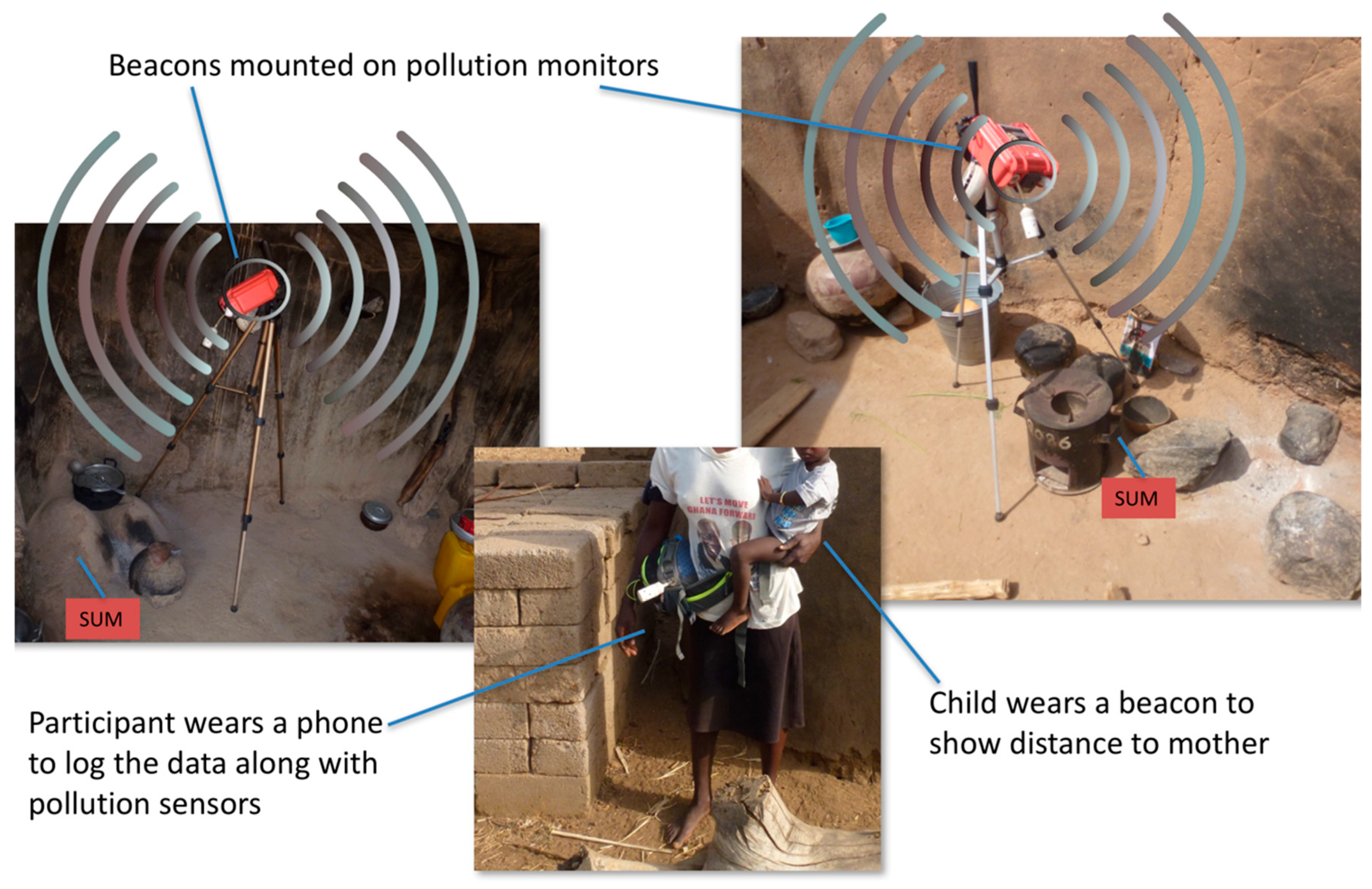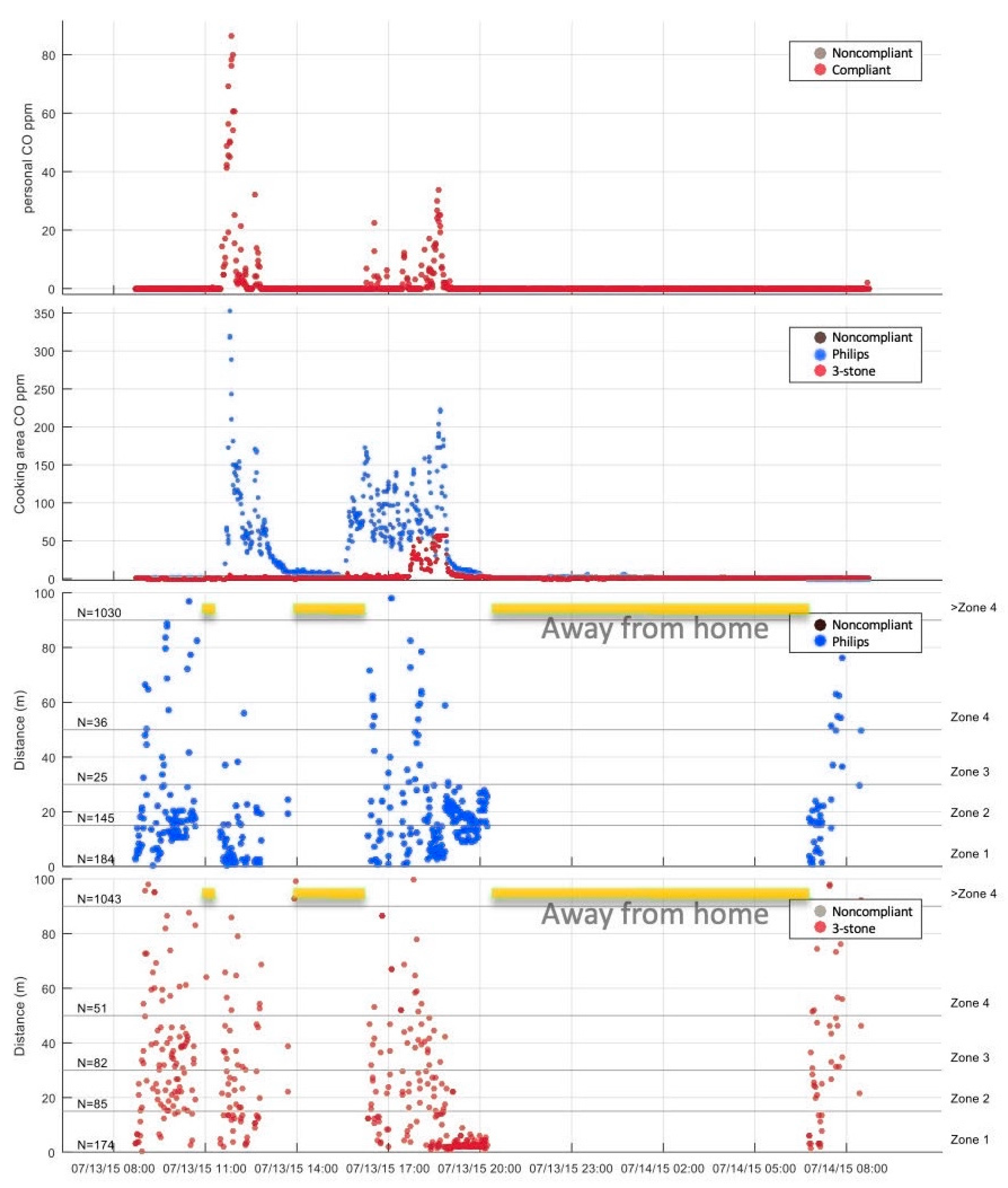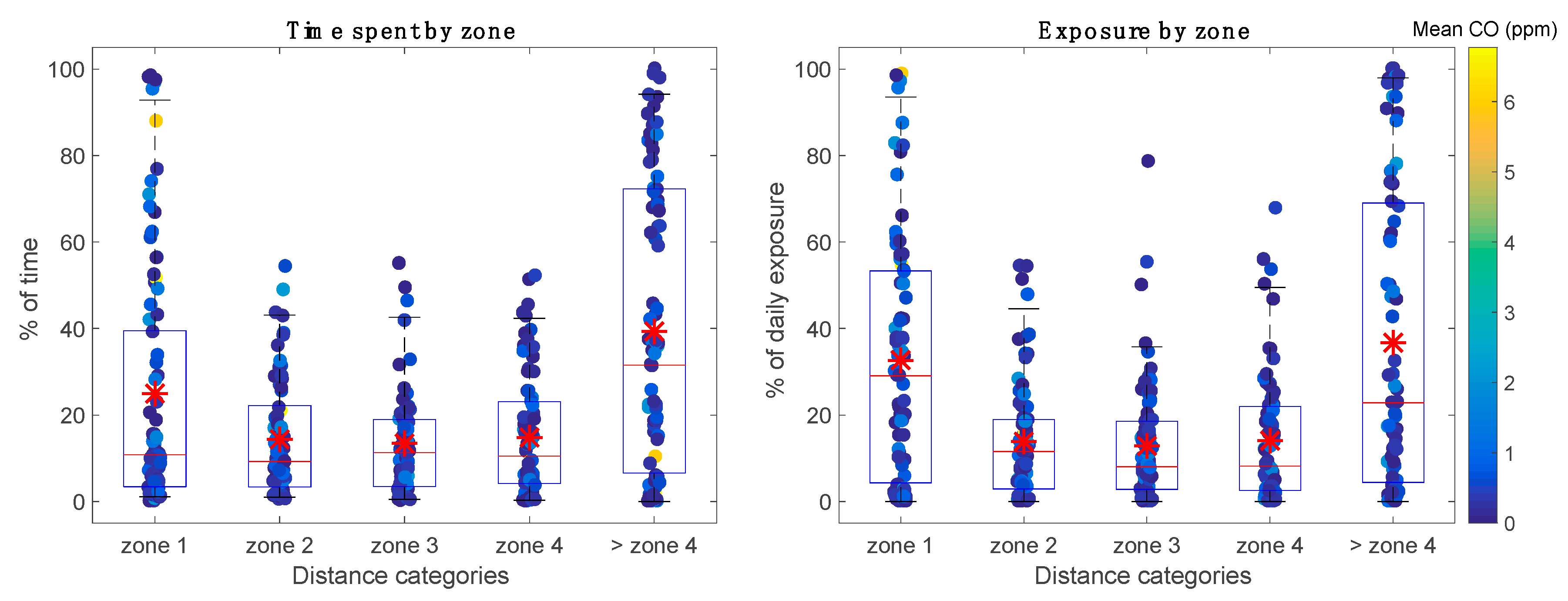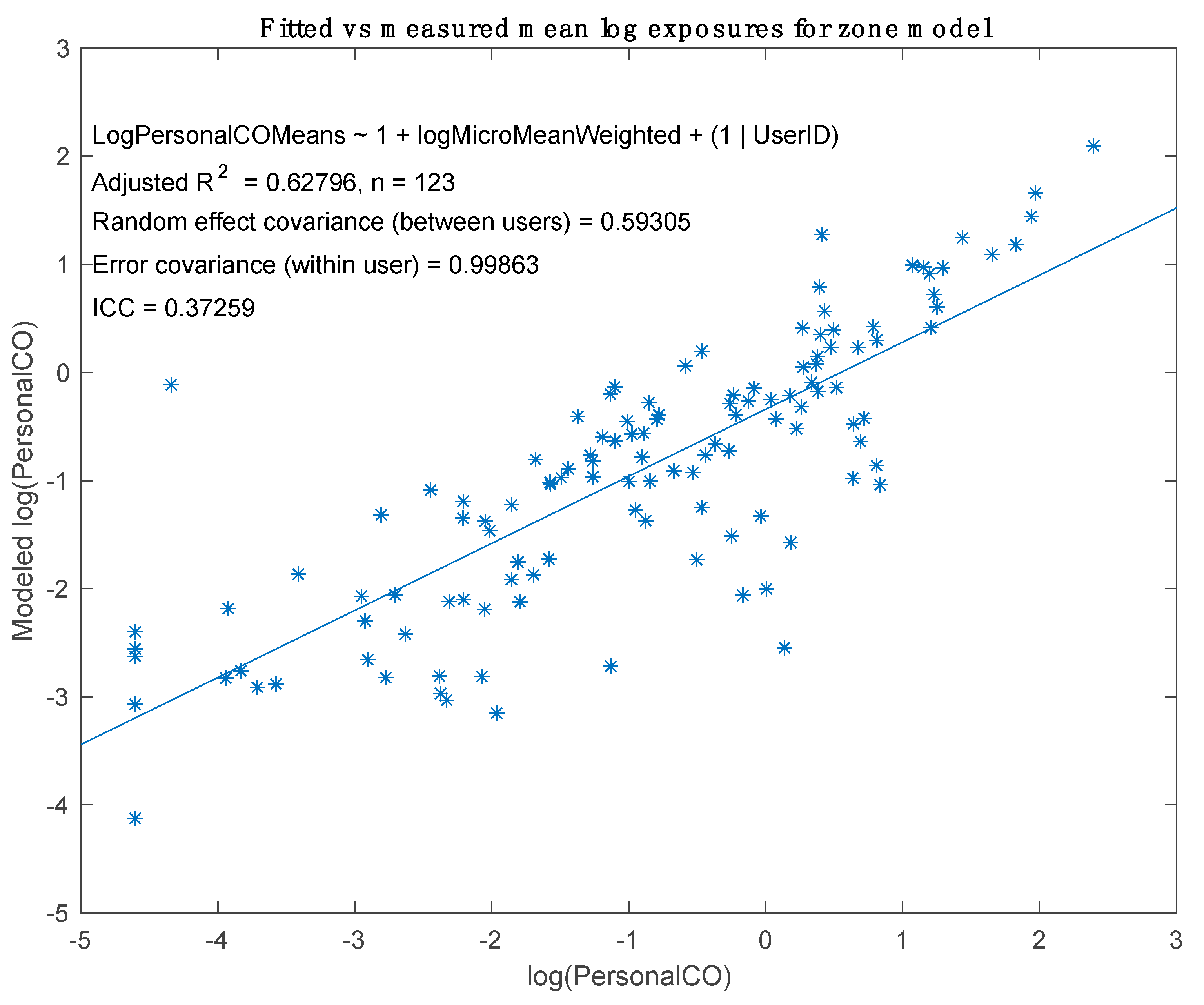Attributing Air Pollutant Exposure to Emission Sources with Proximity Sensing
Abstract
1. Introduction
Proximity Monitoring Background
2. Methods
2.1. Sampling System Overview
2.2. BLE Proximity Sensing System
2.2.1. BLE Beacons
2.2.2. BLE Beacon Receivers
2.2.3. BLE Beacon Data Processing
2.3. Proximity Calibration and Validation
2.4. Attributing CO Exposure as a Function of Time-Activity Category
Modeling CO Exposure Using Proximity and Microenvironment Monitoring
3. Results
3.1. Time-Activity Results
3.2. Exposure by Proximity
3.3. CO Personal Exposure Results Using Home vs. Away Categorization
3.4. Personal CO Exposure Modeling Using Cooking Microenvironment CO
4. Discussion
5. Conclusions
Supplementary Materials
Author Contributions
Ethical Considerations
Funding
Acknowledgments
Conflicts of Interest
References
- Gakidou, E.; Afshin, A.; Abajobir, A.A.; Abate, K.H.; Abbafati, C.; Abbas, K.M.; Abd-Allah, F.; Abdulle, A.M.; Abera, S.F.; Aboyans, V.; et al. Global, regional, and national comparative risk assessment of 84 behavioural, environmental and occupational, and metabolic risks or clusters of risks, 1990–2016: A systematic analysis for the Global Burden of Disease Study 2016. Lancet 2017, 390, 1345–1422. [Google Scholar] [CrossRef]
- Mortimer, K.; Ndamala, C.B.; Naunje, A.W.; Malava, J.; Katundu, C.; Weston, W.; Havens, D.; Pope, D.; Bruce, N.G.; Nyirenda, M.; et al. A cleaner burning biomass-fuelled cookstove intervention to prevent pneumonia in children under 5 years old in rural Malawi (the Cooking and Pneumonia Study): A cluster randomised controlled trial. Lancet 2017, 389, 167–175. [Google Scholar] [CrossRef]
- Bruce, N.; McCracken, J.; Albalak, R.; Scheid, M.; Smith, K.R.; Lopez, V.; West, C. Impact of improved stoves, house construction and child location on levels of indoor air pollution exposure in young Guatemalan children. J. Expo. Sci. Environ. Epidemiol. 2004, 14, S26–S33. [Google Scholar] [CrossRef] [PubMed]
- Quinn, A.K.; Ae-Ngibise, K.A.; Jack, D.W.; Boamah, E.A.; Enuameh, Y.; Mujtaba, M.N.; Chillrud, S.N.; Wylie, B.J.; Owusu-Agyei, S.; Kinney, P.L.; et al. Association of Carbon Monoxide exposure with blood pressure among pregnant women in rural Ghana: Evidence from GRAPHS. Int. J. Hyg. Environ. Health 2016, 219, 176–183. [Google Scholar] [CrossRef] [PubMed]
- Coffey, E.R.; Muvandimwe, D.; Hagar, Y.; Wiedinmyer, C.; Kanyomse, E.; Piedrahita, R.; Dickinson, K.L.; Oduro, A.; Hannigan, M.P. New Emission Factors and Efficiencies from in-Field Measurements of Traditional and Improved Cookstoves and Their Potential Implications. Environ. Sci. Technol. 2017, 51, 12508–12517. [Google Scholar] [CrossRef] [PubMed]
- Piedrahita, R.; Dickinson, K.L.; Kanyomse, E.; Coffey, E.; Alirigia, R.; Hagar, Y.; Rivera, I.; Oduro, A.; Dukic, V.; Wiedinmyer, C.; et al. Assessment of cookstove stacking in Northern Ghana using surveys and stove use monitors. Energy Sustain. Dev. 2016, 34, 67–76. [Google Scholar] [CrossRef]
- Piedrahita, R.; Kanyomse, E.; Coffey, E.; Xie, M.; Hagar, Y.; Alirigia, R.; Agyei, F.; Wiedinmyer, C.; Dickinson, K.L.; Oduro, A.; et al. Exposures to and origins of carbonaceous PM2.5 in a cookstove intervention in Northern Ghana. Sci. Total. Environ. 2017, 576, 178–192. [Google Scholar] [CrossRef]
- Huang, W.; Baumgartner, J.; Zhang, Y.; Wang, Y.; Schauer, J.J. Source apportionment of air pollution exposures of rural Chinese women cooking with biomass fuels. Atmos. Environ. 2015, 104, 79–87. [Google Scholar] [CrossRef]
- Quinn, C.W.; Miller-Lionberg, D.D.; Klunder, K.J.; Kwon, J.; Noth, E.M.; Mehaffy, J.; Leith, D.; Magzamen, S.; Hammond, S.K.; Henry, C.S.; et al. Personal Exposure to PM2.5 Black Carbon and Aerosol Oxidative Potential using an Automated Microenvironmental Aerosol Sampler (AMAS). Environ. Sci. Technol. 2018, 52, 11267–11275. [Google Scholar] [CrossRef]
- Liao, J.; McCracken, J.P.; Piedrahita, R.; Thompson, L.; Mollinedo, E.; Canuz, E.; De Leon, O.; Diaz, A.; Johnson, M.; Clark, M.L.; et al. The Use of Bluetooth Low Energy Beacon Systems to Assess Indirect Personal Exposure to Household Air Pollution. J. Expo. Sci. Environ. Epidemiol. Accept. 2018. [Google Scholar]
- Pillarisetti, A.; Allen, T.; Ruiz-Mercado, I.; Edwards, R.; Chowdhury, Z.; Garland, C.; Hill, L.D.; Johnson, M.; Litton, C.D.; Lam, N.L.; et al. Small, Smart, Fast, and Cheap: Microchip-Based Sensors to Estimate Air Pollution Exposures in Rural Households. Sensors 2017, 17, 1879. [Google Scholar] [CrossRef] [PubMed]
- Dickinson, K.L.; Kanyomse, E.; Piedrahita, R.; Coffey, E.; Rivera, I.J.; Adoctor, J.; Alirigia, R.; Muvandimwe, D.; Dove, M.; Dukic, V.; et al. Research on Emissions, Air quality, Climate, and Cooking Technologies in Northern Ghana (REACCTING): Study rationale and protocol. BMC Public Heal. 2015, 15, 126. [Google Scholar] [CrossRef]
- Oduro, A.R.; Wak, G.; Azongo, D.; Debpuur, C.; Wontuo, P.; Kondayire, F.; Welaga, P.; Bawah, A.; Nazzar, A.; Williams, J.; et al. Profile of the Navrongo Health and Demographic Surveillance System. Int. J. Epidemiol. 2012, 41, 968–976. [Google Scholar] [CrossRef] [PubMed]
- Dickinson, K.L.; Piedrahita, R.; Coffey, E.; Kanyomse, E.; Alirigia, R.; Molnar, T.; Hagar, Y.; Hannigan, M.P.; Oduro, A.; Wiedinmyer, C. Adoption of improved biomass stoves and stove/fuel stacking in the REACCTING intervention study in Northern Ghana. Energy Policy 2019, 130, 361–374. [Google Scholar] [CrossRef]
- Wiedinmyer, C.; Dickinson, K.; Piedrahita, R.; Kanyomse, E.; Coffey, E.; Hannigan, M.; Alirigia, R.; Oduro, A. Rural–urban differences in cooking practices and exposures in Northern Ghana. Environ. Res. Lett. 2017, 12, 065009. [Google Scholar] [CrossRef]
- Albalak, R.; Keeler, G.J.; Frisancho, A.R.; Haber, M. Assessment of PM10Concentrations from Domestic Biomass Fuel Combustion in Two Rural Bolivian Highland Villages. Environ. Sci. Technol. 1999, 33, 2505–2509. [Google Scholar] [CrossRef]
- Balakrishnan, K.; Sambandam, S.; Ramaswamy, P.; Mehta, S.; Smith, K.R. Exposure assessment for respirable particulates associated with household fuel use in rural districts of Andhra Pradesh, India. J. Expo. Sci. Environ. Epidemiol. 2004, 14, S14–S25. [Google Scholar] [CrossRef]
- Balakrishnan, K.; Sankar, S.; Parikh, J.; Padmavathi, R.; Srividya, K.; Venugopal, V.; Prasad, S.; Pandey, V.L.; Parikh, J. Daily average exposures to respirable particulate matter from combustion of biomass fuels in rural households of southern India. Environ. Heal. Perspect. 2002, 110, 1069–1075. [Google Scholar] [CrossRef] [PubMed]
- Brauer, M.; Amann, M.; Burnett, R.T.; Cohen, A.; Dentener, F.; Ezzati, M.; Henderson, S.B.; Krzyzanowski, M.; Martin, R.V.; Van Dingenen, R.; et al. Exposure assessment for estimation of the global burden of disease attributable to outdoor air pollution. Environ. Sci. Technol. 2012, 46, 652–660. [Google Scholar] [CrossRef] [PubMed]
- Cynthia, A.A.; Edwards, R.D.; Johnson, M.; Zuk, M.; Rojas, L.; Jiménez, R.D.; Riojas-Rodriguez, H.; Masera, O. Reduction in personal exposures to particulate matter and carbon monoxide as a result of the installation of a Patsari improved cook stove in Michoacan Mexico. Indoor Air 2008, 18, 93–105. [Google Scholar] [CrossRef]
- Dionisio, K.L.; Howie, S.R.C.; Dominici, F.; Fornace, K.M.; Spengler, J.D.; Donkor, S.; Chimah, O.; Oluwalana, C.; Ideh, R.C.; Ebruke, B.; et al. The exposure of infants and children to carbon monoxide from biomass fuels in The Gambia: A measurement and modeling study. J. Expo. Sci. Environ. Epidemiol. 2012, 22, 173–181. [Google Scholar] [CrossRef] [PubMed]
- Baumgartner, J.; Schauer, J.J.; Ezzati, M.; Lu, L.; Cheng, C.; Patz, J.; Bautista, L.E. Patterns and predictors of personal exposure to indoor air pollution from biomass combustion among women and children in rural China. Indoor Air 2011, 21, 479–488. [Google Scholar] [CrossRef] [PubMed]
- Patel, S.; Li, J.; Pandey, A.; Pervez, S.; Chakrabarty, R.K.; Biswas, P. Spatio-temporal measurement of indoor particulate matter concentrations using a wireless network of low-cost sensors in households using solid fuels. Environ. Res. 2017, 152, 59–65. [Google Scholar] [CrossRef] [PubMed]
- Freeman, N.C.; De Tejada, S.S. Methods for collecting time/activity pattern information related to exposure to combustion products. Chemosphere 2002, 49, 979–992. [Google Scholar] [CrossRef]
- Clark, M.L.; Peel, J.L.; Balakrishnan, K.; Breysse, P.N.; Chillrud, S.N.; Naeher, L.P.; Rodes, C.E.; Vette, A.F.; Balbus, J.M. Health and Household Air Pollution from Solid Fuel Use: The Need for Improved Exposure Assessment. Environ. Health Perspect. 2013, 121, 1120–1128. [Google Scholar] [CrossRef] [PubMed]
- Elgethun, K.; Fenske, R.A.; Yost, M.G.; Palcisko, G.J. Time-location analysis for exposure assessment studies of children using a novel global positioning system instrument. Environ. Health Perspect. 2003, 111, 115–122. [Google Scholar] [CrossRef]
- Rooney, M.S.; Arku, R.E.; Dionisio, K.L.; Paciorek, C.; Friedman, A.B.; Carmichael, H.; Zhou, Z.; Hughes, A.F.; Vallarino, J.; Agyei-Mensah, S.; et al. Spatial and temporal patterns of particulate matter sources and pollution in four communities in Accra, Ghana. Sci. Total Environ. 2012, 435, 107–114. [Google Scholar] [CrossRef]
- Ni, L.M.; Liu, Y.; Lau, Y.C.; Patil, A.P. LANDMARC: Indoor Location Sensing Using Active RFID. Wirel. Netw. 2004, 10, 701–710. [Google Scholar] [CrossRef]
- Cheng, K.-C.; Tseng, C.-H.; Hildemann, L.M. Using Indoor Positioning and Mobile Sensing for Spatial Exposure and Environmental Characterizations: Pilot Demonstration of PM2.5 Mapping. Environ. Sci. Technol. Lett. 2019, 6, 153–158. [Google Scholar] [CrossRef]
- Kwapisz, J.R.; Weiss, G.M.; Moore, S.A. Activity recognition using cell phone accelerometers. ACM SIGKDD Explor. Newsl. 2011, 12, 74. [Google Scholar] [CrossRef]
- Piedrahita, R.; Coffey, E.; Kanyomse, E.; Hagar, Y.; Wiedinmyer, C.; Dickinson, K.L.; Oduro, A.R.; Hannigan, M.P. Exposures to carbon monoxide in a cookstove intervention in Northern Ghana. Atmosphere 2019, in press. [Google Scholar]
- Benatar, S. Reflections and recommendations on research ethics in developing countries. Soc. Sci. Med. 2002, 54, 1131–1141. [Google Scholar] [CrossRef]
- Madhavapeddy, A.; Tse, A. A Study of Bluetooth Propagation Using Accurate Indoor Location Mapping. In UbiComp 2005: Ubiquitous Computing; Beigl, M., Intille, S., Rekimoto, J., Tokuda, H., Eds.; Lecture Notes in Computer Science; Springer: Berlin, Germany, 2005; pp. 105–122. ISBN 978-3-540-28760-5. [Google Scholar]
- Zanca, G.; Zorzi, F.; Zanella, A.; Zorzi, M. Experimental Comparison of RSSI-based Localization Algorithms for Indoor Wireless Sensor Networks. In Proceedings of the Workshop on Real-world Wireless Sensor Networks, Glasgow, Scotland, UK, 1–4 April 2008; ACM: New York, NY, USA, 2008; pp. 1–5. [Google Scholar]
- Dahlgren, E.; Mahmood, H. Evaluation of indoor positioning based on Bluetooth Smart technology. Master’s Thesis, Chalmers University of Technology, Gothenburg, Sweden, June 2014. [Google Scholar]
- Pollard, J.; Zhou, S. Position measurement using Bluetooth. IEEE Trans. Consum. Electron. 2006, 52, 555–558. [Google Scholar]
- Özkaynak, H. Exposure Assessment. In Air Pollution and Health; Holgate, S.T., Koren, H.S., Samet, J.M., Maynard, R.L., Eds.; Academic Press: Cambridge, MA, USA, 1999; pp. 149–162. ISBN 978-0-08-052692-8. [Google Scholar]
- Zuk, M.; Rojas, L.; Blanco, S.; Serrano, P.; Cruz, J.; Angeles, F.; Tzintzun, G.; Armendariz, C.; Edwards, R.D.; Johnson, M.; et al. The impact of improved wood-burning stoves on fine particulate matter concentrations in rural Mexican homes. J. Expo. Sci. Environ. Epidemiol. 2007, 17, 224–232. [Google Scholar] [CrossRef] [PubMed]
- Dionisio, K.L.; Howie, S.R.C.; Dominici, F.; Fornace, K.M.; Spengler, J.D.; Adegbola, R.A.; Ezzati, M. Household concentrations and exposure of children to particulate matter from biomass fuels in The Gambia. Environ. Sci. Technol. 2012, 46, 3519–3527. [Google Scholar] [CrossRef] [PubMed]
- Allen-Piccolo, G.; Rogers, J.V.; Edwards, R.; Clark, M.C.; Allen, T.T.; Ruiz-Mercado, I.; Shields, K.N.; Canuz, E.; Smith, K.R. An Ultrasound Personal Locator for Time-Activity Assessment. Int. J. Occup. Environ. Health 2009, 15, 122–132. [Google Scholar] [CrossRef] [PubMed]




| All Available Days with Personal CO and Beacon Data | ‘Home Cooking by Stove Group’ vs. ‘Home Not Cooking’ vs. ‘Away’ Data Set (Equation (1)) | Personal vs. Cooking Area CO by Zones (Equation (2)) | Daily Average Personal vs. Cooking Area CO (Equation (3)) | ||
|---|---|---|---|---|---|
| Duration | Compliant and non-flagged periods deployed | 279 (time-activity periods) | 107 (time-activity periods) | 123 (zone-days) | 38 (days) |
| Daily compliant duration in hours (mean (SD)) | 19.9 (3.25) | 20.28 (3.6) | 20.94 (3.48) | 20.22 (3.81) | |
| Unique participants | 31 | 22 | 21 | 22 | |
| Gender covariates (activity periods) | Primary cook Females | 228 | 101 | 115 | 36 |
| Non-primary cook females | 51 | 6 | 8 | 2 | |
| Males | 0 | 0 | 0 | 0 | |
| Age of females over 5y (med, SD, max, min) | 38.4, 12.9, 12.3, 73.4 | 39.4, 14.2, 73.4, 12.3 | 39.4, 14.2, 73.4, 12.3 | 39.4, 14.8, 73.4, 12.3 | |
| Age of females under 5y (med, SD, max, min) | 2.1, 0.9, 1.9, 4.2 | 3.3, 0.5, 3.8, 2.9 | 3.3, 0.5, 3.8, 2.9 | 3.3, 0.6, 3.8, 2.9 | |
| SES (activity periods) | Poorest | 48 | 24 | 30 | 30 |
| Poorer | 72 | 24 | 26 | 26 | |
| Poor | 69 | 12 | 15 | 15 | |
| Less poor | 27 | 20 | 23 | 23 | |
| Least poor | 63 | 27 | 29 | 29 | |
| Seasons (activity periods) | Harmattan | 150 | 37 | 47 | 13 |
| Hot dry | 23 | 11 | 15 | 4 | |
| Light Rainy | 31 | 20 | 25 | 4 | |
| Heavy Rainy | 75 | 39 | 36 | 14 | |
| Transition | 0 | 0 | 0 | 0 | |
| Stove Group (activity periods) | Control | 31 | 14 | 15 | 6 |
| Gyapa/Philips | 48 | 27 | 28 | 9 | |
| Philips/Philips | 110 | 29 | 31 | 10 | |
| Gyapa/Gyapa | 90 | 37 | 49 | 13 |
| Average Personal Exposure vs. ‘Home Cooking’, ‘Home Not Cooking’, and ‘Away’ (Equation (1)) | Total Integrated Personal Exposure vs. ‘Home Cooking’, ‘Home Not Cooking’, and ‘Away’ (Equation (2)) | |||||||
|---|---|---|---|---|---|---|---|---|
| Expected value ppm (95% CI) | Coefficient (95% CI) | % change (95% CI) | P-value | Expected value (ppm*hr) | Coefficient (95% CI) | % change (95% CI) | P-value | |
| Intercept (control group home cooking) | 3.62 (0.78, 16.75) | 1.29 (−0.24, 2.82) | NA | 0.10 | 11.57 (1.69, 79.07) | 2.45 (0.53, 4.37) | NA | 0.01 |
| Gyapa/Gyapa Home cooking | 0.64 (0.10, 4.05) | −1.74 (−3.58, 0.11) | −82.4 (−97.2, 11.7) | 0.07 | 0.64 (0.06, 6.45) | −2.9 (−5.22, −0.58) | −94.5 (−99.5, −44.2) | 0.01 |
| Philips/Philips Home cooking | 1.36 (0.20, 9.2) | −0.98 (−2.89, 0.93) | −62.4 (−94.4, 153.8) | 0.31 | 3.26 (0.3, 35.89) | −1.26 (−3.66, 1.13) | −71.8 (−97.4, 210.3) | 0.30 |
| Gyapa/Philips Home cooking | 0.69 (0.10, 4.62) | −1.67 (−3.57, 0.24) | −81.1 (−97.2, 27.6) | 0.09 | 0.84 (0.08, 9.28) | −2.62 (−5.01, −0.22) | −92.7 (−99.3, −19.7) | 0.03 |
| Home not cooking | 0.18 (0.04, 0.94) | −2.99 (−4.62, −1.35) | −95.0 (−99.0, −74.2) | <0.01 | 1.27 (0.16, 9.83) | −2.21 (−4.26, −0.16) | −89.0 (−98.6, −15.0) | 0.03 |
| Away from home | 0.13 (0.02, 0.65) | −3.36 (−4.99, −1.72) | −96.5 (−99.3, −82.2) | <0.01 | 0.46 (0.06, 3.59) | −3.22 (−5.27, −1.17) | −96.0 (−99.5, −69.0) | <0.01 |
| Equation (1) | Equation (2) | |||||||
| Random effect by individual variance | 0 | 0 | ||||||
| Random error variance | 2.98 (2.28, 3.89) | 4.69 (3.59, 6.14) | ||||||
| Adjusted R-squared | 0.20 | 0.08 | ||||||
| N | 107 | 107 | ||||||
© 2019 by the authors. Licensee MDPI, Basel, Switzerland. This article is an open access article distributed under the terms and conditions of the Creative Commons Attribution (CC BY) license (http://creativecommons.org/licenses/by/4.0/).
Share and Cite
Piedrahita, R.; Coffey, E.R.; Hagar, Y.; Kanyomse, E.; Verploeg, K.; Wiedinmyer, C.; Dickinson, K.L.; Oduro, A.; Hannigan, M.P. Attributing Air Pollutant Exposure to Emission Sources with Proximity Sensing. Atmosphere 2019, 10, 395. https://doi.org/10.3390/atmos10070395
Piedrahita R, Coffey ER, Hagar Y, Kanyomse E, Verploeg K, Wiedinmyer C, Dickinson KL, Oduro A, Hannigan MP. Attributing Air Pollutant Exposure to Emission Sources with Proximity Sensing. Atmosphere. 2019; 10(7):395. https://doi.org/10.3390/atmos10070395
Chicago/Turabian StylePiedrahita, Ricardo, Evan R. Coffey, Yolanda Hagar, Ernest Kanyomse, Katelin Verploeg, Christine Wiedinmyer, Katherine L. Dickinson, Abraham Oduro, and Michael P. Hannigan. 2019. "Attributing Air Pollutant Exposure to Emission Sources with Proximity Sensing" Atmosphere 10, no. 7: 395. https://doi.org/10.3390/atmos10070395
APA StylePiedrahita, R., Coffey, E. R., Hagar, Y., Kanyomse, E., Verploeg, K., Wiedinmyer, C., Dickinson, K. L., Oduro, A., & Hannigan, M. P. (2019). Attributing Air Pollutant Exposure to Emission Sources with Proximity Sensing. Atmosphere, 10(7), 395. https://doi.org/10.3390/atmos10070395






